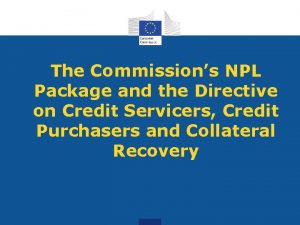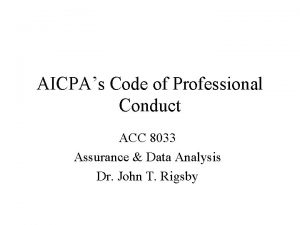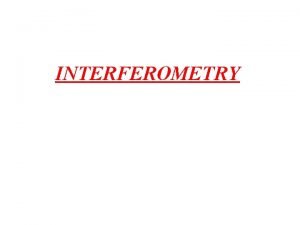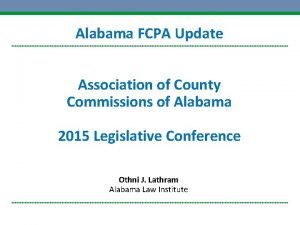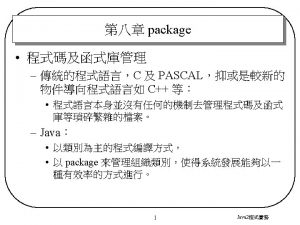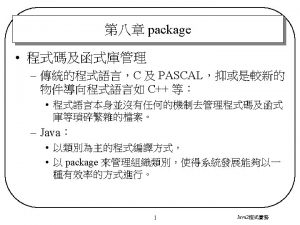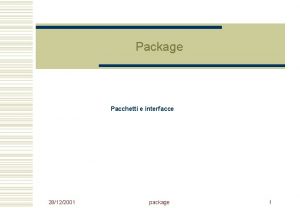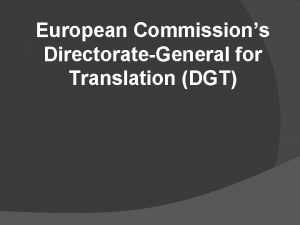The Commissions NPL Package and the Directive on
















- Slides: 16

The Commission’s NPL Package and the Directive on Credit Servicers, Credit Purchasers and Collateral Recovery

Non-performing loans as impediment to bank lending and economic recovery Member States with high NPL had weaker bank lending (even when different GDP growth is accounted for) Banks with high NPL have difficulties to obtain capital and funding 2

NPLs: Declining but still high • Non-performing loans (NPLs) are one of the remaining legacy risks in the European banking system. • Despite the significant progress already made, NPLs continue to pose risks to economic growth and financial stability. 3

The Council’s NPL Action Plan • Mandates tasks to COM, EBA, ECA, ESRB and Member States • Includes push and pull-factors. 4

The Commission’s NPL package • Based on the Council Action Plan to Tackle NPLs, the Commission put forward a comprehensive package of measures that will speed up the reduction of NPLs in Europe. • It will create the appropriate environment for dealing with current NPLs and reduce the risk of future NPL accumulation. The proposed actions will enable banks and Member States to address NPLs in a more determined way than before. 5

Elements of the NPL package • The package consists of two legislative proposals and a staff working document providing non-binding technical guidance (a so-called ‘blueprint’) for how national Asset Management Companies (AMCs) can be set up by Member States, if they so wish. • Together, these proposals will: o enhance the prudential tools needed to effectively address NPLs; o encourage the development of secondary markets for NPLs; o facilitate debt recovery by enhancing the protection of secured creditors in an extrajudicial proceeding; and o [assist Member States – that so wish – in the restructuring of their banks by establishing AMCs dealing with NPLs. ] 5

Statutory prudential backstop What? Instrument: Measure to ensure sufficient loss coverage by banks for future NPLs A Regulation amending the Capital Requirements Regulation (CRR) Objective: • To introduce common minimum coverage levels for newly originated loans that become non-performing. • The minimum coverage levels will act as a statutory prudential backstop. The measure addresses the risk of not having enough money to cover losses on future NPLs and prevents their accumulation. 7

Secondary markets for NPLs: economic effects 8

Content of the Directive What? Instrument: To improve the conditions for market entry for NPL buyers and loan servicing firms. Directive on credit servicers, credit purchasers and the recovery of collateral Objective: • The proposal defines the activities of credit servicers, sets common standards for authorisation and supervision, and imposes conduct rules across the EU. As such, the proposal facilitates cross-border activities. • The proposal does not affect contract law principles under national law • Consumer protection is ensured by legal safeguards and transparency rules so that the transfer of a loan does not affect the rights and interest of the borrower. 9

Access to the European NPL market What changes? Safeguards for borrowers • No authorisation for credit purchasers in any Member State but authorities are informed of the transfer. • All legal protections applied to the bank loan remain in place. • Proportionate supervision incentivises credit purchasers and servicers to treat borrowers fairly. • Authorisation of credit servicers based on fit-andproper criteria. • Third-country purchasers of consumer loans to have them serviced by an authorised EU credit servicer or by a bank. • Authorisation for credit servicers; can passport their services across the EU. • Third-country purchasers to appoint a legal representative in the EU. 10

Collateral enforcement: economic effects 11

Accelerated extrajudicial collateral enforcement What? Instrument: Measure to provide more efficient value recovery from secured loans Directive on credit servicers, credit purchasers and the recovery of collateral Objective: • To provide secured creditors with an efficient mechanism, based on and requiring upfront contractual agreement, for outof-court value recovery from collateral. • If the borrower defaults on the loan, such accelerated extrajudicial collateral enforcement will allow creditors to enforce the collateral securing the loan in an expedited way, without going to court. • Strictly limited to loans granted to businesses: Consumer loans are excluded. Various safeguards for the borrower ensure a balanced mechanism. 12

Accelerated extrajudicial collateral enforcement: Safeguards • Consumer loans excluded; • Borrower can challenge the use of the mechanism in court; • Borrower’s first residences excluded; • Excess proceeds to be turned over to the borrower; and • Only upon upfront agreement between creditor and borrower; • Member States may put in place a rule that even where the proceeds from the collateral fall short of the amount outstanding on the loan, the loan shall be considered fully settled. • Rules on fair valuation; 13

A strong package with mutually reinforcing measures The proposals would not be as effective if implemented in isolation 14

AMC Blueprint What? Instrument: A technical guidance for how national AMCs can be set up Staff working document non-binding, non-legislative Objective: • To guide Member States on how they can set up national AMCs, should they find it useful, in full compliance with EU banking and State aid rules. Setting up an AMC is voluntary. • While considering AMCs with a State aid element as an exceptional solution, the blueprint clarifies the permissible design of AMCs, if receiving public support. • The blueprint suggests a number of common principles, on the set-up, governance and operations of AMCs. The blueprint draws on experience and best practices from AMCs already set up in Member States. 15

Conclusion • NPLs are still an important challenge for the European banking system. The total volume of NPLs across the EU remains well above pre-crisis levels. • Tackling this issue is supported by the economic recovery. Yet more is needed. • The Commission therefore launched a comprehensive package of “push” and “pull” measures to address the NPL challenge. As Europe and its economy regain strength, we must seize the momentum and further reduce risks in the banking sector, accelerating the reduction of NPLs as well as preventing future build-ups of NPLs. 16
 What is a graduated commission
What is a graduated commission Npl directive
Npl directive 5-3 commissions royalties and piecework pay answer key
5-3 commissions royalties and piecework pay answer key Commissions royalties and piecework pay
Commissions royalties and piecework pay 5-3 commissions royalties and piecework pay answers
5-3 commissions royalties and piecework pay answers What is immediate family considered
What is immediate family considered Janice earns $3 750
Janice earns $3 750 Npl flatness interferometer light source
Npl flatness interferometer light source Npl certificate in educational leadership
Npl certificate in educational leadership Npl netball
Npl netball Fcpa alabama
Fcpa alabama Basic concept of strategic management
Basic concept of strategic management Supportive behavior
Supportive behavior Merits of non directive counselling
Merits of non directive counselling Enthusiastic beginner disillusioned learner
Enthusiastic beginner disillusioned learner Packaging and packaging waste directive
Packaging and packaging waste directive Rare consequential and directive
Rare consequential and directive

